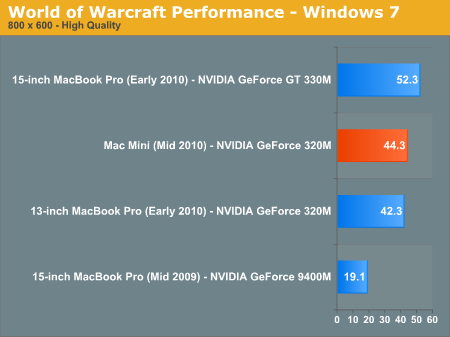Apple Mac mini Review (Mid 2010)
by Anand Lal Shimpi on August 9, 2010 3:37 AM ESTGaming Performance
Two years ago Apple (and NVIDIA) sent a clear message to Intel - its integrated graphics was no longer good enough. For the second largest consumer of semiconductors in the world to publicly tell Intel that its graphics wasn’t enough had to be a wake-up call. I was surprised that it took Intel until this year to really heed the call. The Larrabee announcement and subsequent increase in integrated graphics investment tells us that Intel is finally trying to win this business back. But today, Apple definitely values putting more money towards GPUs than CPUs. The 2010 13-inch MacBook Pro was our first example, where Apple opted against moving to a Core i3/i5 in order to ship with a NVIDIA GPU. The Mac mini continues the trend as Apple sticks to last year’s Penryn based Core 2 Duo P8600 instead of moving to a Core i3. In fact, one look at the mini’s box reveals Apple’s thinking:

iLife, NVIDIA graphics and WiFi are the only things mentioned on the packaging. There’s not a single mention of Intel being inside the Mac mini. Even on Apple’s website, the Intel shoutouts are limited. If I were a betting man I’d say that Apple is gearing up to eventually support AMD CPUs as well as Intel. The first Fusion parts might be a logical starting point.
With a growing installed user base and a higher guaranteed minimum GPU level, the Mac platform is becoming more attractive to game developers. Steam is now alive and well on OS X and last month’s Starcraft 2 release ships with both OS X and Windows versions on the same disc.
The 2010 Mac mini is basically a 13-inch MacBook Pro in a different form factor. The GeForce 320M GPU isn’t fast, but it’s fast enough to run things like Half Life 2 at playable frame rates. Unfortunately Starcraft 2 came out after I already sent the mini back so I couldn’t get a feel for how well it would run on the mini. For what it’s worth, Apple’s current NVIDIA drivers included in OS X 10.6.4 are absolutely horrible for performance in Starcraft 2. Even a GeForce GTX 285 runs like garbage under OS X with those drivers, you need to use the latest betas from NVIDIA which unfortunately only work on the GTX 285 (at least the installer portion).

Performance is a bit lower than the 13-inch MacBook Pro in our OS X Half Life 2 Episode Two test, presumably because of the meager 2GB of memory the system ships with by default compared to the 4GB you get with the MBP.
The 2008 iMac is still considerably faster since it uses a faster CPU and a much faster dedicated GPU. The 8800M GS has more shader horsepower and runs at a higher clock than the GeForce 320M. There’s also the matter of the dedicated frame buffer (512MB) vs. the shared memory setup on the Mac mini.
The mini is good enough for today’s games on the Mac (although not at 1080p). I would expect its GPU to feel slow after another year.











93 Comments
View All Comments
Johnexo - Saturday, December 11, 2010 - link
The Mac Mini remains unique as the smallest mainstream desktop, but competition from Dell and HP has narrowed the gap in features while also offering room for expansion, and at a better price.RJARRRPCGP - Saturday, June 9, 2012 - link
The errors are probably because the SATA interface is SATA 1 and it not being backward-compatible. You must get a SATA 2 card.666an666 - Monday, May 13, 2013 - link
"Disconnect all of the temperature sensors and cable connectors from the back of the board..."Huh? Can you be more specific? Where are "all of the temperature sensors" connected? I only see two connectors: IR sensor and power supply. Where are all these other sensor connectors???